A year has now passed since Seradata, a Slingshot Aerospace company, and Numerica Space (also now part of Slingshot Aerospace), broke the news to the world that Russia had destroyed one of their own satellites in Low Earth Orbit (LEO). What has happened since that destructive, anti-satellite (ASAT) test?
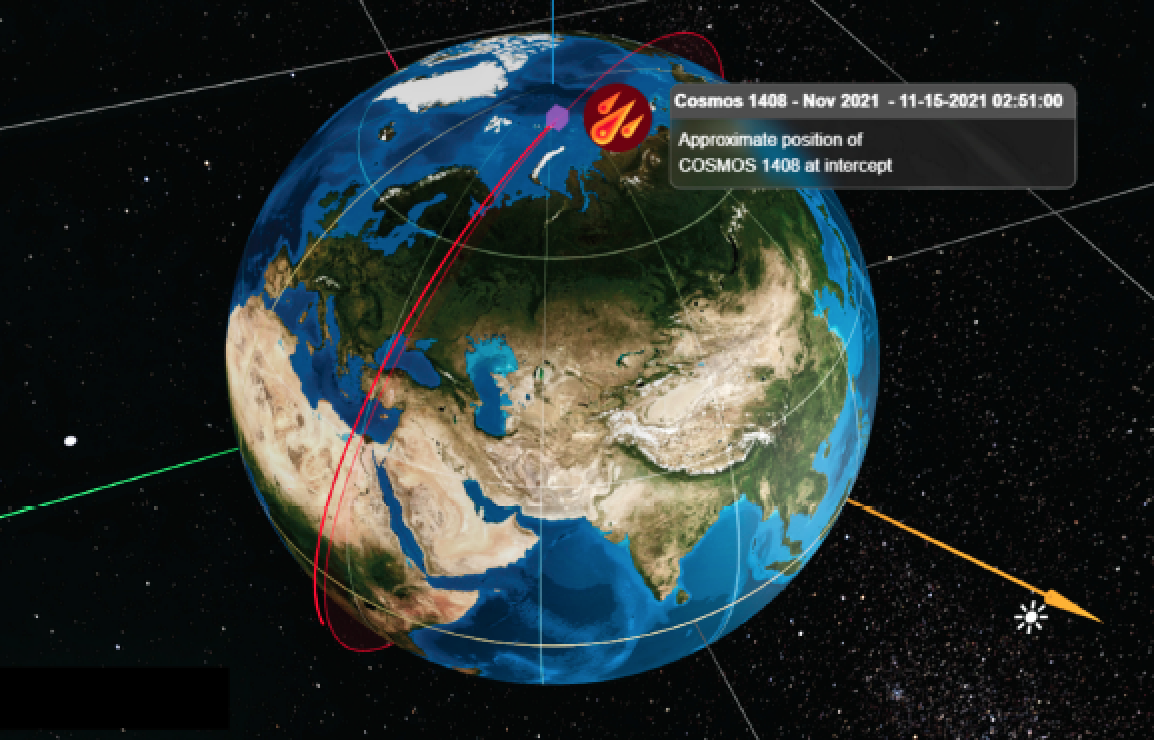 Image generated by Slingshot Laboratory of predicted position based on TLE with 11/13/21 Epoch. (Space-track.org)
Image generated by Slingshot Laboratory of predicted position based on TLE with 11/13/21 Epoch. (Space-track.org)
Around 0246 GMT on November 15, 2021, a Russian A-235/PL-19 Nudol missile (photo to the right) was launched from Plesetsk in Northern Russia. Approximately five minutes later, the missile intercepted a defunct Soviet-era satellite — Cosmos 1408 — at an altitude of 470km, causing 1,789 pieces of tracked debris, some of which are likely to last for at least 15 years in orbit.
Cosmos 1408 was a 2,000kg., Tselina-D class, signals intelligence satellite that was launched in 1982 and which had been out of service for several decades. When the satellite was struck, it exploded, causing a “debris cloud” that threatened other spacecraft — including the International Space Station (ISS).
A few hours after that impact, the United States State Department confirmed that an ASAT test had taken place and that an alert had been sent to the American, German and Russian crew onboard the ISS.
This “safe haven” protocol alarm procedure was activated at 0900 GMT on the ISS. The seven crew members aboard were instructed to don their space suits, shelter in their spacecraft (Crew Dragon Endurance and Soyuz MS-19) and prepare for possible evacuation, should the ISS be struck. They remained in these shelters for approximately six hours before getting an all-clear to return to their normal activities.
It was the relative proximity of the orbits and the short warning that was of particular concern. The ISS’s orbit was close enough to the debris field to potentially experience a conjunction threat every 93 minutes due to the wreckage that had been generated by the Russian ASAT test.
The creation of the respective debris cloud caused international protest. Then-NASA Administrator, Bill Nelson, said, “I’m outraged by this irresponsible and destabilizing action. With its long and storied history in human spaceflight, it is unthinkable that Russia would endanger not only the American and international partner astronauts on the ISS, but also their own cosmonauts. Their actions are reckless and dangerous, threatening, as well, [to] the Chinese space station and the taikonauts on board.”
The initial emergency for the ISS crew was not the only one the crew members had to face. The ISS maneuvers infrequently, on average once a year, to avoid space debris. Since the ASAT in November of 2021, the ISS has had to maneuver multiple times to dodge the Cosmos 1408 debris.
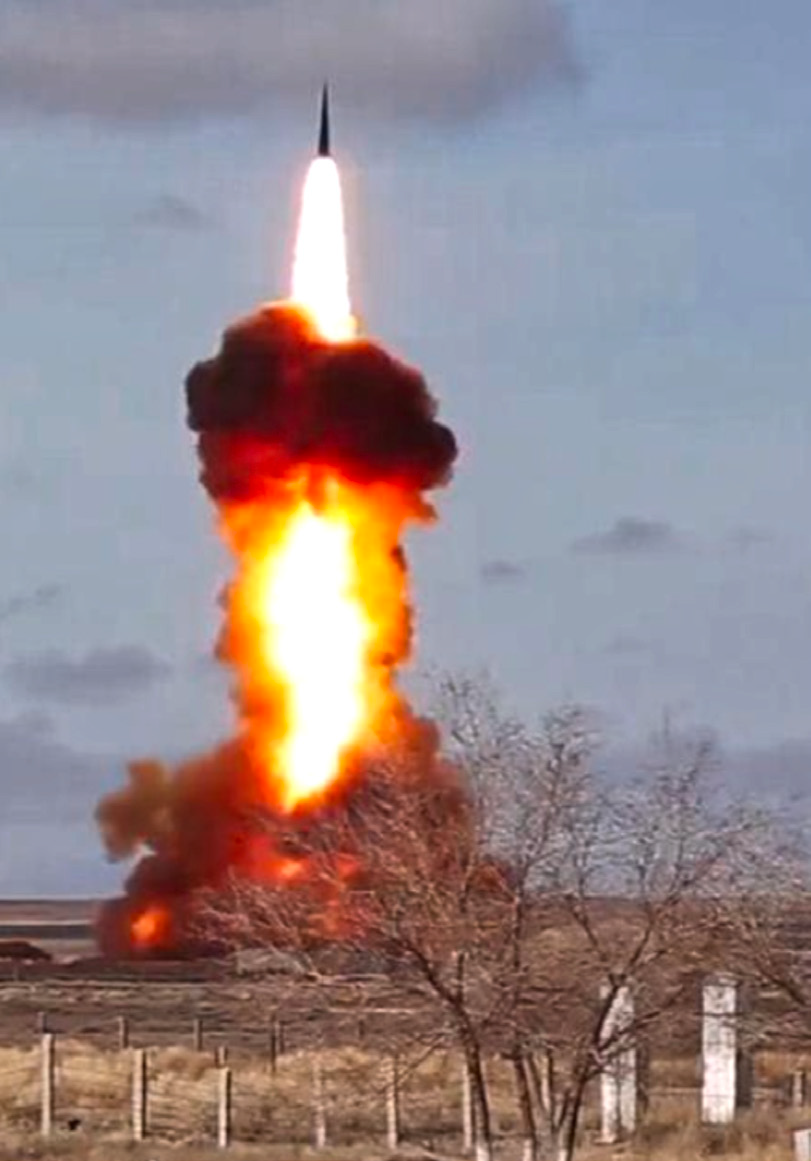
A-235/PL-19 Nudol missile launch.
Courtesy:Russian Ministry of Defence via
Globalsecurity.org
On October 25, 2022, the docked Progress MS-20 (Progress 81P) cargo spacecraft had to fire their thrusters for 5 minutes and 5 seconds in a Predetermined Debris Avoidance Maneuver (PDAM). This was to drive the spacecraft and the attached ISS complex an extra measure of distance away from the predicted track of a fragment of Cosmos 1408 debris.
In addition to the ISS, other spacecraft have had several close encounters with Cosmos debris. According to data from Slingshot Beacon, the event has generated 2,587,750 conjunction data messages (CDMs), meaning there have been more than 2.5 million proximity alerts that operators have had to evaluate from this single, debris-generating event.
Debris Cloud Remains With Us
According to Space-Track.org, one month after the interception, 500 pieces of debris had been tracked, a total that later rose to nearly 1,800 pieces.
Based on the TLE data available at space-track.org, before impact and first available after impact days later, the main Cosmos 1408 body was likely impacted from behind as the resulting fragment’s orbital energy was of a larger magnitude after the collision.
Although this data would suggest the relative velocity of the two objects at impact would be lower, this type of collision could be considered more perilous in the sense that the resulting debris would remain on-orbit for years and, potentially, more than a decade, due to the increase in orbital energy magnitude.
Additionally, the steeper geometry of the collision dispersed the resulting fragments — at higher velocities — in wider spread.
Whichever way the debris gets there, the concern remains that some orbits are now becoming increasingly populated with spacecraft — especially those used by the large satellite constellations — and any debris intersecting respective orbits of these constellations might, one day, result in a chain reaction of cascading debris formation, potentially causing the “Kessler Syndrome” theory that was posed by Donald Kessler in 1978.
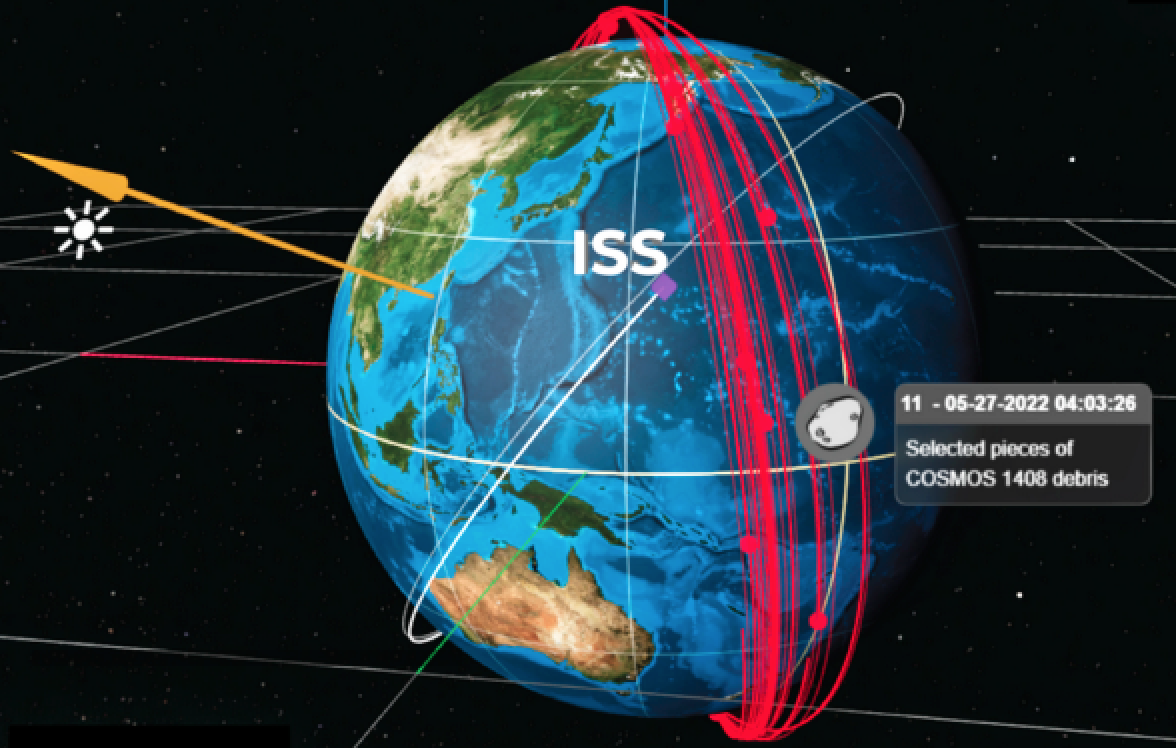 Simulation created in Slingshot Laboratory showing how the International Space Station (ISS) crosses through the path of Cosmos 1408’s ASAT interception debris.
Simulation created in Slingshot Laboratory showing how the International Space Station (ISS) crosses through the path of Cosmos 1408’s ASAT interception debris.
As it is, with so much space junk and live satellites already in these orbits, adding more debris further aggravates the problem. Without a clear, global, space traffic coordination solution geared toward this level of scale (such as Slingshot Beacon), space sustainability faces a serious threat.
How Seradata + Slingshot Discovered The ASAT Test
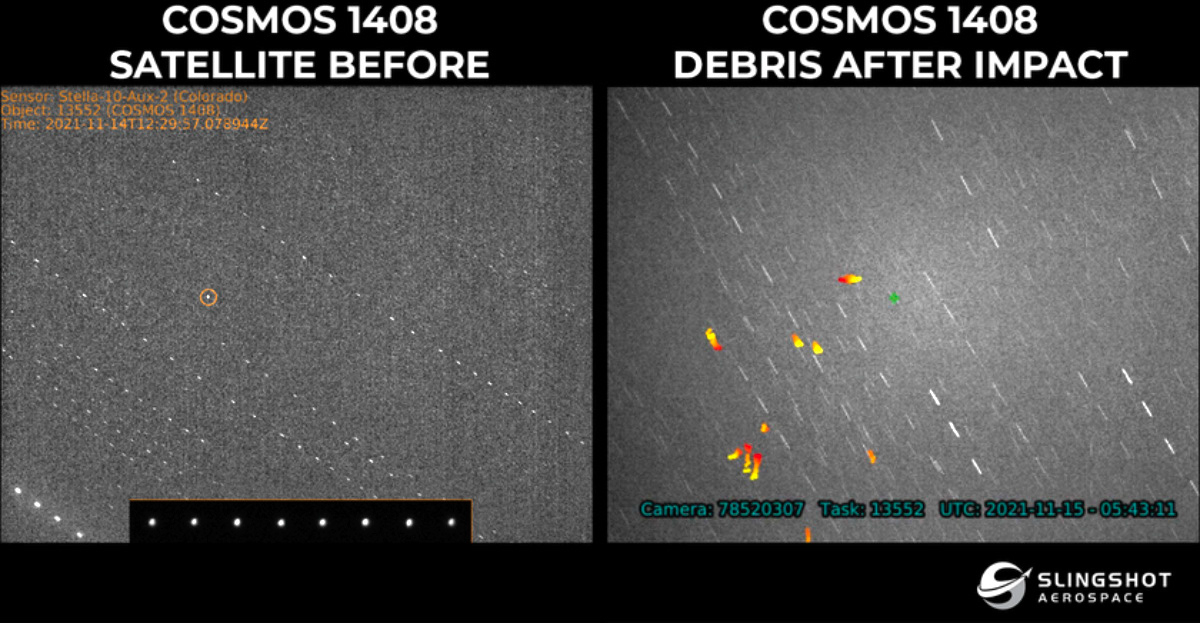
Slingshot received early news of the ASAT missile launch through the Slingshot Global Sensor Network that had been monitoring Cosmos 1408. The telescope system in Morocco detected the debris cloud within a few hours after impact. With this early detection, Slingshot was able to release the first images of the aftermath of the collision (image above).
The images revealed that the debris was rapidly moving away from a point of origin within a few hours of the impact. These first images also indicated that some of the larger pieces were breaking apart in the process, creating even more debris.
Additionally, at the time, the space industry’s leading launch and satellite database provider, Seradata (now a Slingshot Aerospace company) was involved in a SACT (Sprint Advanced Concept Training) exercise.
SACT was a method for the United States and its allies to technically assess commercial Space Domain Awareness (SDA) capabilities and does so via global exercises based on real and simulated space events. Real world events are included in the exercise and sometimes they can dominate, which was the case on November 15, 2021. Because of this exercise, Seradata was the first to break the news to the world via Twitter.
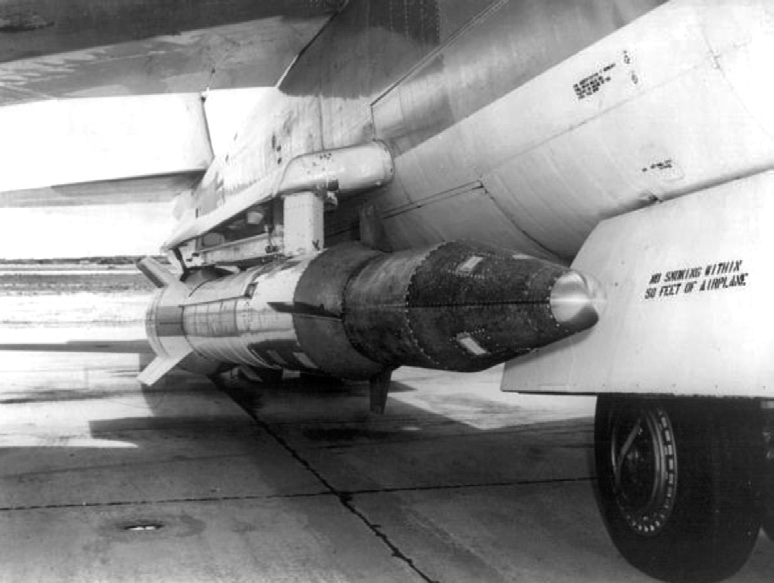
A B- 47 aircraft with a Bold Orion missile in position.
Photo is courtesy of the U.S.A.F.
The History of direct Ascent ASAT Missile Tests
ASAT missile tests have been carried out since the late 1950s. The first successful close pass was made by a B-47 Stratojet, air-launched, Bold Orion/Altair missile that attempted to intercept Explorer 6 on October 13, 1959.
The realization was that, given the 6.4km pass distance, a nuclear warhead would have been required to reach the spacecraft and put it out of action. Exploding nuclear weapons in space to cause damage was explored as a secondary effect of Starfish Prime.
On July 9, 1962, the United States Air Force detonated Starfish Prime, the highest space nuclear test ever conducted. The effects of the test created an artificial solar storm that included auroras, geomagnetic activity, and damaged electric systems as far as 800 miles away from the explosion. Six satellites were reportedly damaged.
Air-launched missiles gave way to other methods with the Soviet Union. In 1968, the Soviets began testing explosive “killer satellite” technology. The testing stopped when the Soviets declared the first official moratorium on ASAT testing. Yet, two years later, in 1985 when the United States was preparing to launch their first ASAT, the Soviets “considered themselves free” to lift their two-year- old moratorium on ASAT weapons.
The return to air-launched ASATs happened with an F-15A Eagle fighter jet launch of the Vought ASM-135A missile, which successfully intercepted Solwind P78-1, a U.S. gamma ray spectroscopy satellite, at an altitude of 530km on September 13, 1985 (images below). Hundreds of pieces of tracked debris were detected, all of which quickly decayed.
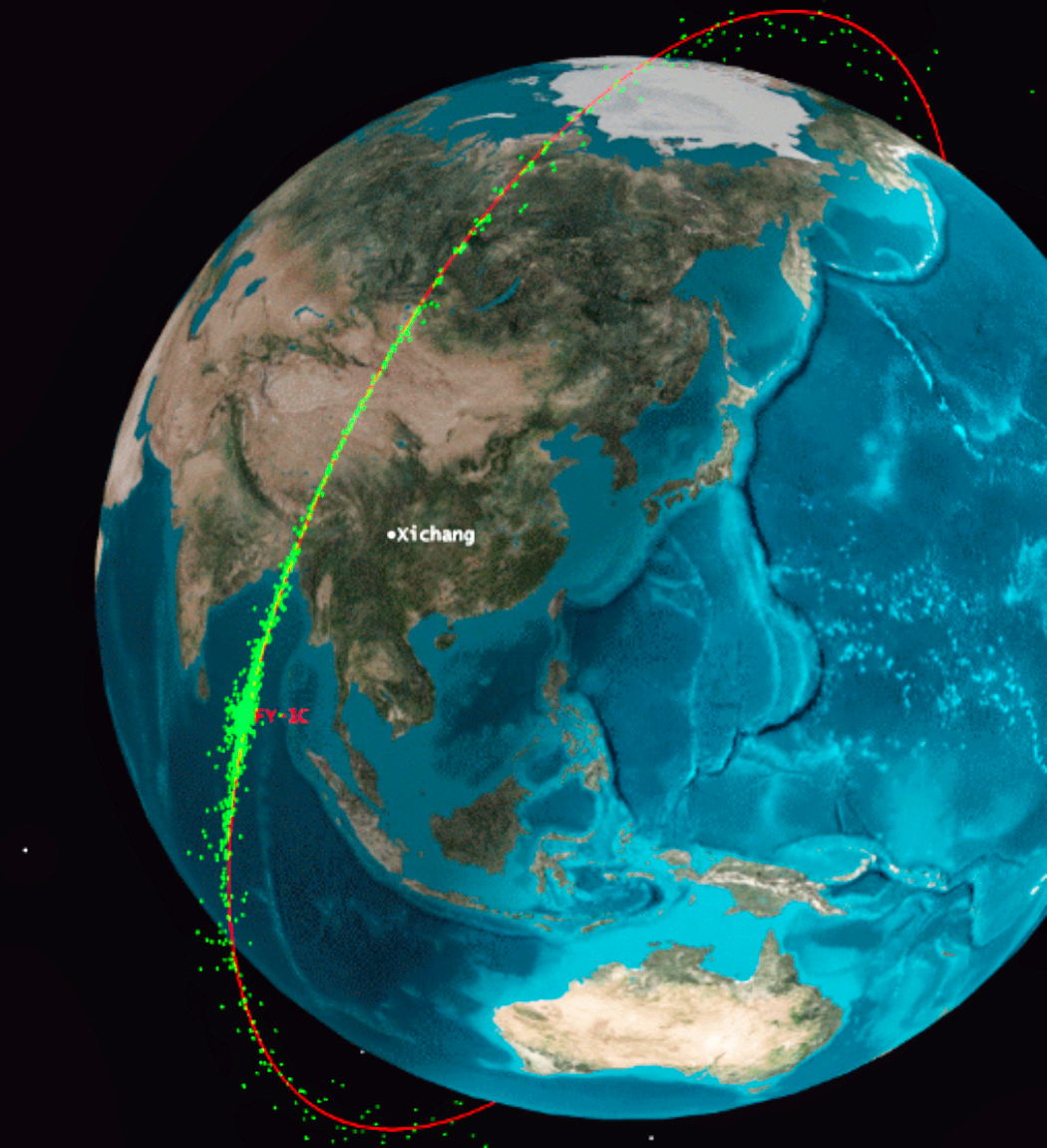
Artistic rendition of the Chinese ASAT test impact 5 minutes
after the impact. Kelso, TS, “Chinese ASAT Test”,
Celestrak.com, www.celestrak.com/events/asat.asp
Rather than an explosive warhead, the missile used an infrared, guided, direct interception technique controlled by a solid rocket thruster. While the test was successful, the United States turned away from ASATs and, instead, concentrated efforts on directed energy beam weaponry.
More recently, as inspection and service satellite technology have matured, China has been developing satellites not to service and repair spacecraft, but to conduct remote operations to physically attach to and manipulate other satellites.
China decided that it needed to demonstrate a direct interception capability of its own. On January 11. 2007, China used a ground-launched SC-19 missile as an interceptor to strike the Chinese Fengyun-1C weather spacecraft at an altitude of 863km.
The resulting debris was found to have more than 3,000 tracked pieces, the majority of which still remains in orbit. The debris cloud triggered international protest over the test. Apart from the space debris risk, the military implication was that any satellites flying in a sun-synchronous orbit (SSO) — as most reconnaissance satellites do — were now at risk of missile strike.
On February 20, 2008, as part of Operation Burnt Frost, a United States Navy Standard Missile-3 (t) missile was fired from the USS Lake Erie. The mission was quickly designed to destroy a non-operational, orbitally decaying, United States National Reconnaissance Office (NRO) satellite, USA-193, to stop its stainless-steel tank of hydrazine fuel from surviving re-entry, which was a threat to human life.
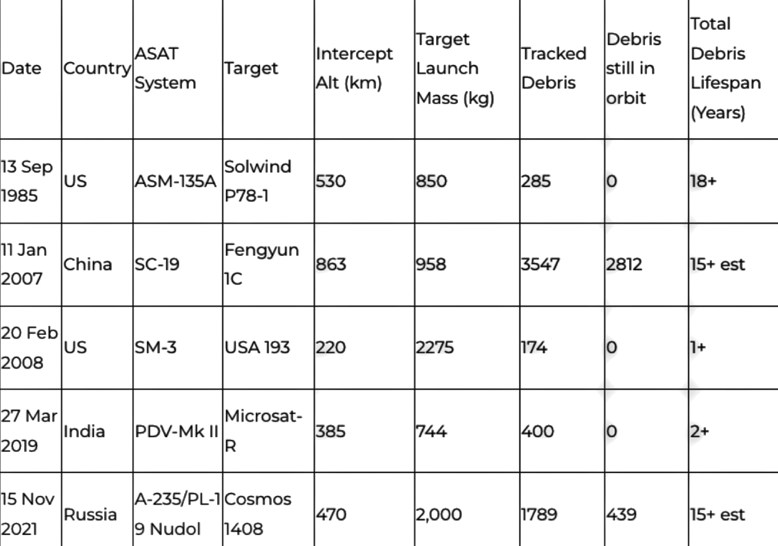 Table 1: Five successful ASAT missile test interceptions to date. Sources: Secure World Alliance/NASA/Seradata SpaceTrak/Space-Track.Org as of November 10, 2022.
Table 1: Five successful ASAT missile test interceptions to date. Sources: Secure World Alliance/NASA/Seradata SpaceTrak/Space-Track.Org as of November 10, 2022.
The SM-3 missile intercepted the satellite USA-193 at 220km altitude, causing it to break up. It was known from the start that the debris would re-enter and burn up within a short time period and would not create a lingering debris field.
The final piece of detectable USA-193 debris re-entered on October 28, 2009.
India performed that nation’s first ASAT missile test on March 27, 2019, when a used PDV-Mk 2 missile destroyed an Indian Microsat-R satellite on-orbit at an altitude of 285km — that impact resulted in 400 pieces of tracked debris. All have now re-entered.
As previously discussed, Russia returned to ASAT missile technology on November 15, 2021, when a Nudol missile struck the Cosmos 1408 spacecraft at an altitude of 470km, causing 1,789 pieces of tracked debris, some of which are likely to last for at least 15 years in orbit.
Where is the Russian ASAT Test Debris Today?
As of October 23, 2022, there were 1,789 pieces of tracked debris from the Russian ASAT interception of Cosmos 1408, of which 439 pieces are still on-orbit (November 10, 2022).
The Gabbard diagram (shown below), which shows the apogee and perigee of Cosmos 1408 and the resulting debris, indicates that the apogees of some parts were boosted all the way up to 700km, with one piece close to 800km. Some pieces were sent downwards, with perigees now significantly below the interception altitude of 470km — some debris were close enough to present a potential, conjunction threat to the ISS.
Space object decay prediction is an inexact science with several variables, not the least of which are the solar weather effect on the thickness of the Earth’s atmosphere. Nevertheless, a rough assessment is possible, using data from the earlier ASM-135A test at a similar altitude. We can, therefore, predict that debris from the Russian test is expected to last on-orbit for approximately 15-20 years.
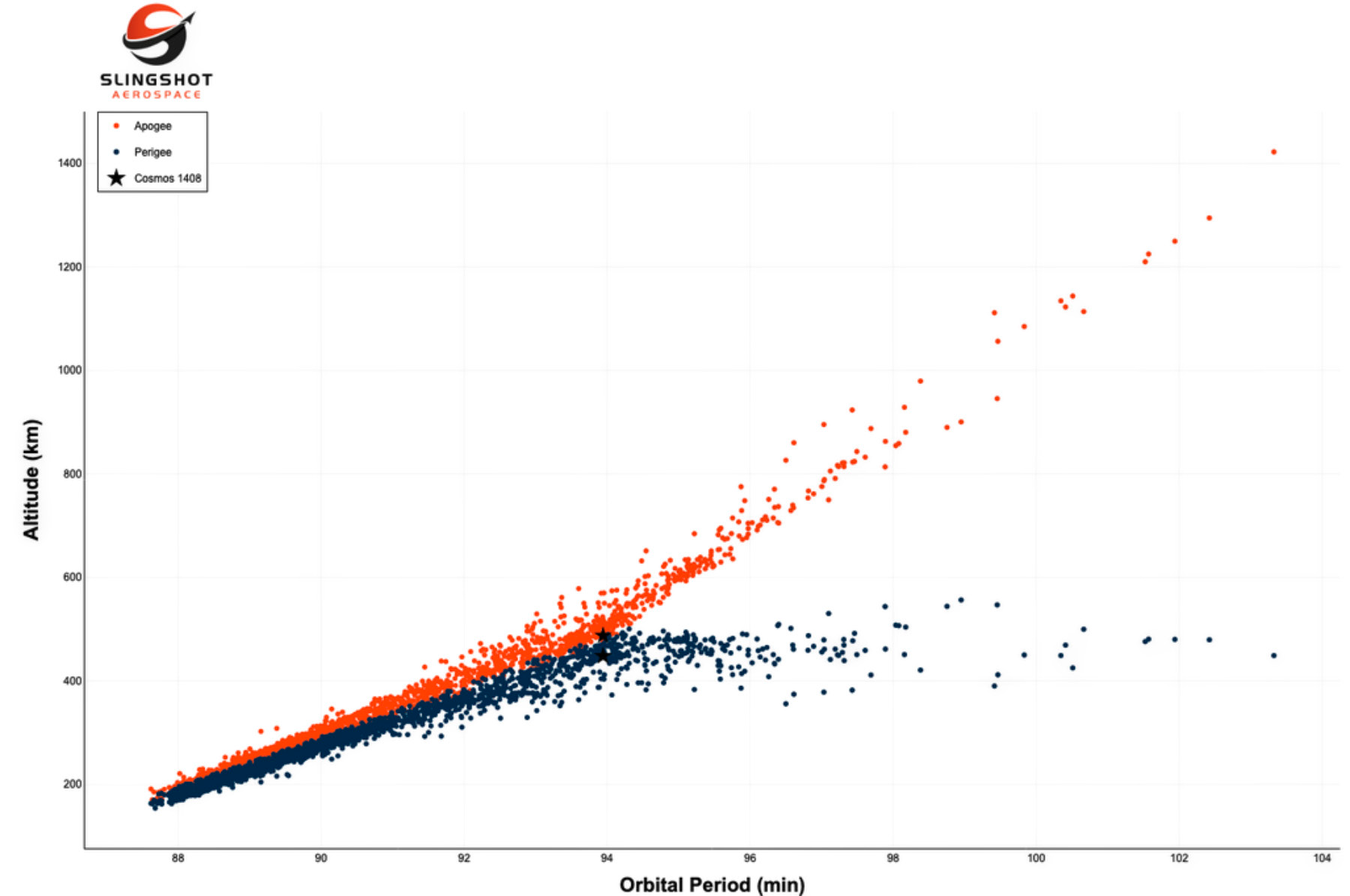 Sources: Secure World Alliance/NASA/Seradata SpaceTrak/Space-Track.Org as of November 10, 2022
Sources: Secure World Alliance/NASA/Seradata SpaceTrak/Space-Track.Org as of November 10, 2022
Putting an End to ASAT Tests
As it stands, only four nations have demonstrated a direct ascent ASAT capability: China, India, the United States and Russia.
While the environment surrounding the use of these weapons has many unknowns, it stands to reason that their use, if carried out against a spacecraft from another country, would have a high likelihood of being regarded as a Casus Belli “act of war” by the receiving party.
As of an announcement in April of 2022, the United States has committed to not conduct destructive, direct-ascent anti-satellite (ASAT ) missile testing and has called on other nations to do the same.
Several other countries have made similar commitments including Canada, New Zealand, Germany, the United Kingdom, Japan, Australia, South Korea, and Switzerland.
Furthermore, the United Nations is concerned about ASAT testing and is moving toward establishing a new set of rules and norms for responsible behavior in space.
In the Fall of 2022 the U.N. First Committee voted on a resolution from the United States to forgo the testing of destructive, debris-creating anti-satellite weapons — 154 countries voted in favor of the resolution, with 10 abstaining and eight opposing, including permanent Security Council Members, China and Russia.
While this is not a legally binding commitment, it is a strong indication of the global interest in restricting the use of such weapons, as well as the work yet to be done to gain international consensus on this topic.
Working Together to Keep Space Safe
Creating more space debris is not in any nation’s best interest as a chain reaction of conflict could quickly render the space domain unusable for humankind. We must push to accelerate work already underway at both international organizations and the national level to ensure a global ban on destructive, debris- causing, ASAT tests.
We must also increase accountability for safe space operations in the orbital environment. Initiatives such as the Space Sustainability Rating are taking the global community in the right direction by challenging space operators to be held to the highest standards of stewardship, but there is still much more to be done.

Today, the highly skilled team at Slingshot Aerospace is developing and deploying cutting edge technologies like Slingshot Beacon, Slingshot Digital Space Twin™ and the Slingshot Global Sensor Network.
These products provide space operators with actionable insights and complete data, so that when faced with the consequences of dangerous or reckless behavior on orbit, such as ASAT tests, they’re able to rapidly and confidently make critical decisions to ensure safety of their operations and of the space operating domain as a whole.
ASAT tests, and the debris they create, are not just a threat to a single satellite — they are a threat to humanity’s future.
At Slingshot Aerospace, we are steadfast in our commitment to accelerating space sustainability and will continue to strongly denounce ASAT tests and other behaviors that endanger the sustainability of our planet and the orbits we all depend on.
slingshotaerospace.com

David Todd
David is Head of Space Content for Seradata, a Slingshot Aerospace company, with overall responsibility for the SpaceTrak launch and satellite database. He is also Editor of Seradata’s news service, Seradata Space Intelligence. David has been a space analyst and consultant working on the SpaceTrak database since 1997 when he acted as the editor for the launch of the original version, launch of the original version then produced by Airclaims.


